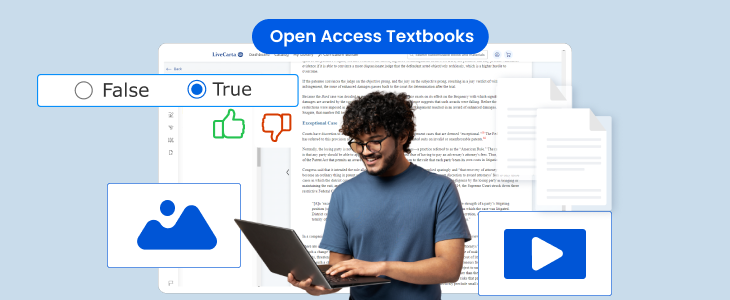The Next Chapter for Open Educational Resources

Open Educational Resources (OER) have transformed the conversation around equity in higher education. By making quality course materials freely accessible, OER significantly reduces the financial barriers for students — saving those in the US and Canada nearly $1 billion in textbook costs. This impact is especially profound for underrepresented and financially disadvantaged students, helping them stay enrolled and complete their courses.
Yet while OER offers affordability and accessibility, it’s only part of the bigger picture. The real challenge lies in helping educators and publishers adapt these resources—and their own content—into flexible, current, and engaging materials that truly meet learning goals.
From Access to Adaptability with Open Educational Resources
Traditional textbooks, even in digital form, still come with limitations: rigid structure, slow updates, and content that doesn’t always match a course’s unique objectives. OER addresses cost and access, but without effective tools, faculty may struggle to adapt and enhance these materials for their students.
That’s where modern digital platforms come in—not simply as repositories, but as environments for active content transformation. Platforms like LiveCarta combine open, licensed, and original materials with features that let educators remix, reorganize, and update content to keep pace with the classroom.
Why Faculty Members Hesitate to Integrate OER
Despite the clear benefits, many faculty members remain cautious about adopting OER. The barriers are often less about the idea itself and more about practical, cultural, and institutional realities:
- Perceived Time and Effort – Finding, reviewing, adapting, and integrating OER into a course can require significant time—especially without institutional support.
- Quality and Effectiveness Concerns – Skepticism remains about whether freely available resources match the rigor and completeness of commercial textbooks, particularly if supplemental materials (quizzes, instructor guides) are lacking.
- Awareness and Familiarity – Many educators are simply unaware of OER’s benefits or the range of high-quality materials available.
- Lack of Incentives and Institutional Support – Without recognition in tenure processes or funding for development, faculty have little incentive to invest time in OER adoption.
- Resistance to Change – Some instructors prefer familiar materials and methods, and may be hesitant to experiment with unfamiliar formats.
- Intellectual Property Concerns – Worries about losing control over one’s work or rights can deter faculty from creating or using OER.
- Technical Challenges – Integrating OER into an institution’s LMS can be difficult without the right tools or technical support.
The good news? Once faculty experience successful OER integration. Especially when supported by intuitive tools their perception often shifts from skepticism to advocacy.
Turning OER into Living, Evolving Resources
When educators have the right digital tools, OER can move beyond “free PDFs” to become dynamic, customizable learning materials. Features like modular content design, AI-powered search, and self-assessment integration allow faculty to:
- Find content/sections they need faster
- Combine materials from multiple sources
- Add context with notes, links, or instructor commentary
- Keep materials updated without reprinting or republishing
- Offer students flexible access options, including chapter-by-chapter purchases for licensed works
For publishers, similar tools make it possible to monetize content flexibly, maintain strong content protection, and set usage permissions while still contributing to affordable education.
Better Learning Outcomes
Ultimately, OER adoption isn’t just about saving students money — it’s about improving learning experiences. By blending open access content with tools that allow for customization, assessment, and ongoing updates, educators can create resources that reflect the realities of their classrooms.
For Faculty: Take the Next Step
If you’re curious about integrating OER into your courses, or you already use OER and want to make it more adaptable, interactive, and relevant, there’s never been a better time to explore your options.
You can browse our catalog of open, licensed, and customizable content to see what’s available, or contact us if you’d like to make your own materials available as open access or for purchase.
With the right tools and support, you can turn great resources into truly transformative learning experiences.
